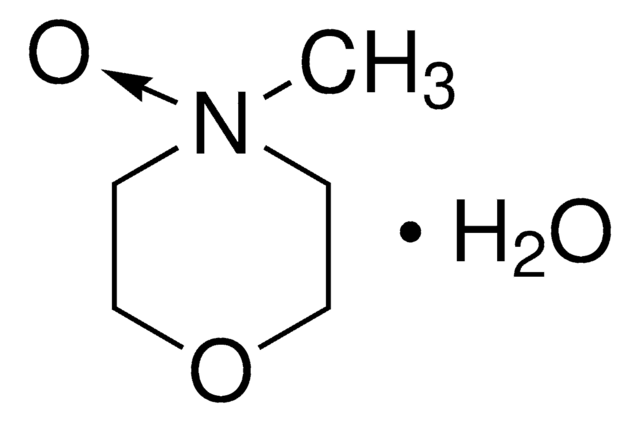330744
Tetrapropylammonium perruthenate
97%
Synonym(s):
TPAP
About This Item
Recommended Products
Assay
97%
form
solid
reaction suitability
reagent type: oxidant
mp
~160 °C (dec.) (lit.)
SMILES string
[O-][Ru](=O)(=O)=O.CCC[N+](CCC)(CCC)CCC
InChI
1S/C12H28N.4O.Ru/c1-5-9-13(10-6-2,11-7-3)12-8-4;;;;;/h5-12H2,1-4H3;;;;;/q+1;;;;-1;
InChI key
NQSIKKSFBQCBSI-UHFFFAOYSA-N
Looking for similar products? Visit Product Comparison Guide
Related Categories
General description
Application
- For the conversion of sulfides to sulfones by oxidation reaction.
- In the isomerization of allylic alcohols into the corresponding saturated carbonyl derivatives.
- Along with N-methylmorpholine N-oxide (NMO) for the cleavage of glycol to carboxylic acids.
TPAP can also be used as an oxidizing reagent:
- For the oxidation of benzyl alcohol to benzaldehyde and steroidal alcohols to corresponding ketones.
- To convert N,N′-dihydroxyimidazolidines to nitronyl nitroxide free radicals.
- To oxidize hydroxyl-substituted tri-n-butylammonium trifluoroborates to aldehydes and ketones without concomitant cleavage of the carbon-boron bond.
Storage Class Code
11 - Combustible Solids
WGK
WGK 3
Flash Point(F)
Not applicable
Flash Point(C)
Not applicable
Personal Protective Equipment
Certificates of Analysis (COA)
Search for Certificates of Analysis (COA) by entering the products Lot/Batch Number. Lot and Batch Numbers can be found on a product’s label following the words ‘Lot’ or ‘Batch’.
Already Own This Product?
Find documentation for the products that you have recently purchased in the Document Library.
Customers Also Viewed
Articles
Oxidation and reduction reactions are some of the most common transformations encountered in organic synthesis, and are some of the organic chemist’s most powerful tools for creating novel products. Below is a list of the most commonly used oxidizing and reducing agents currently available in our catalog.
Our team of scientists has experience in all areas of research including Life Science, Material Science, Chemical Synthesis, Chromatography, Analytical and many others.
Contact Technical Service








